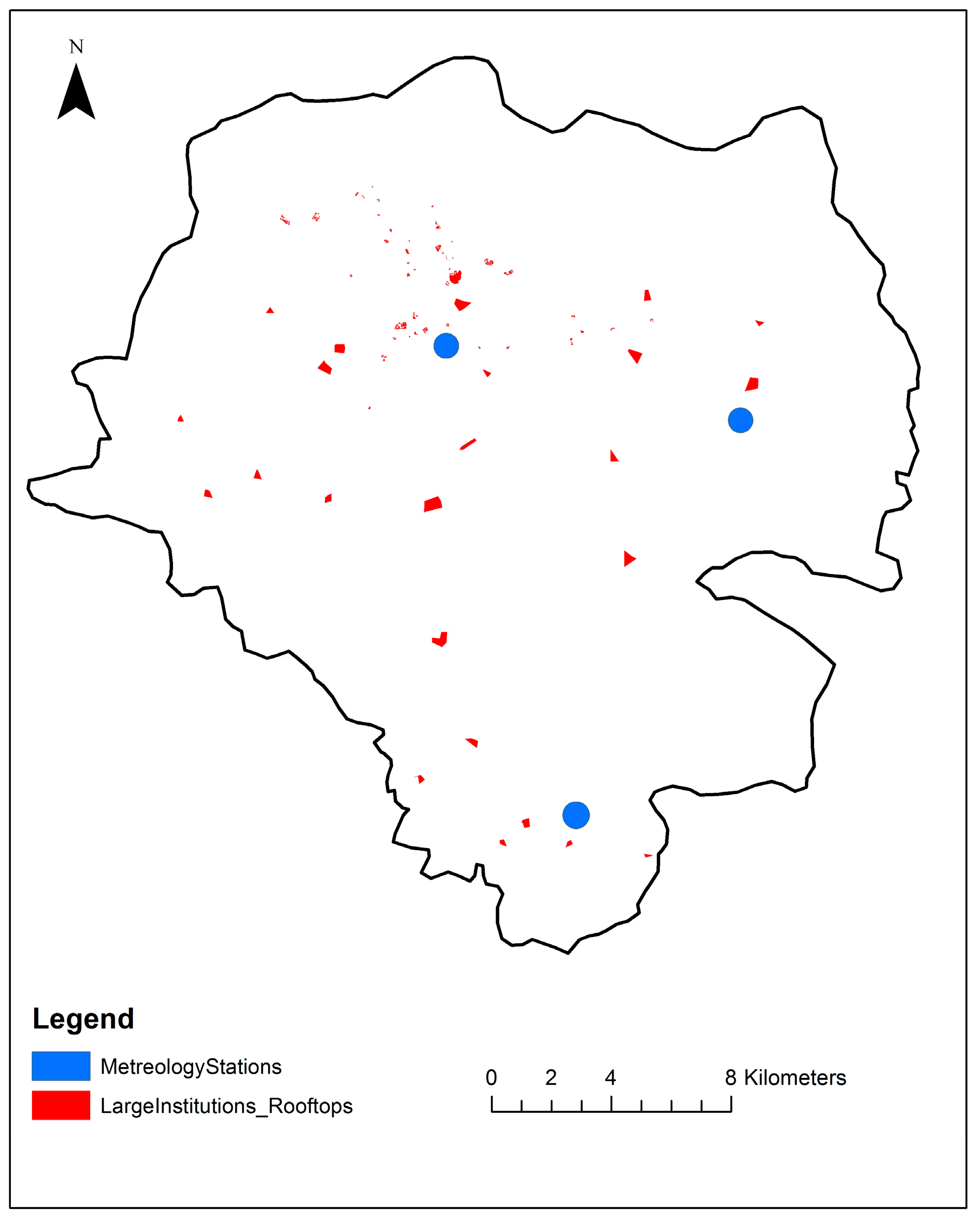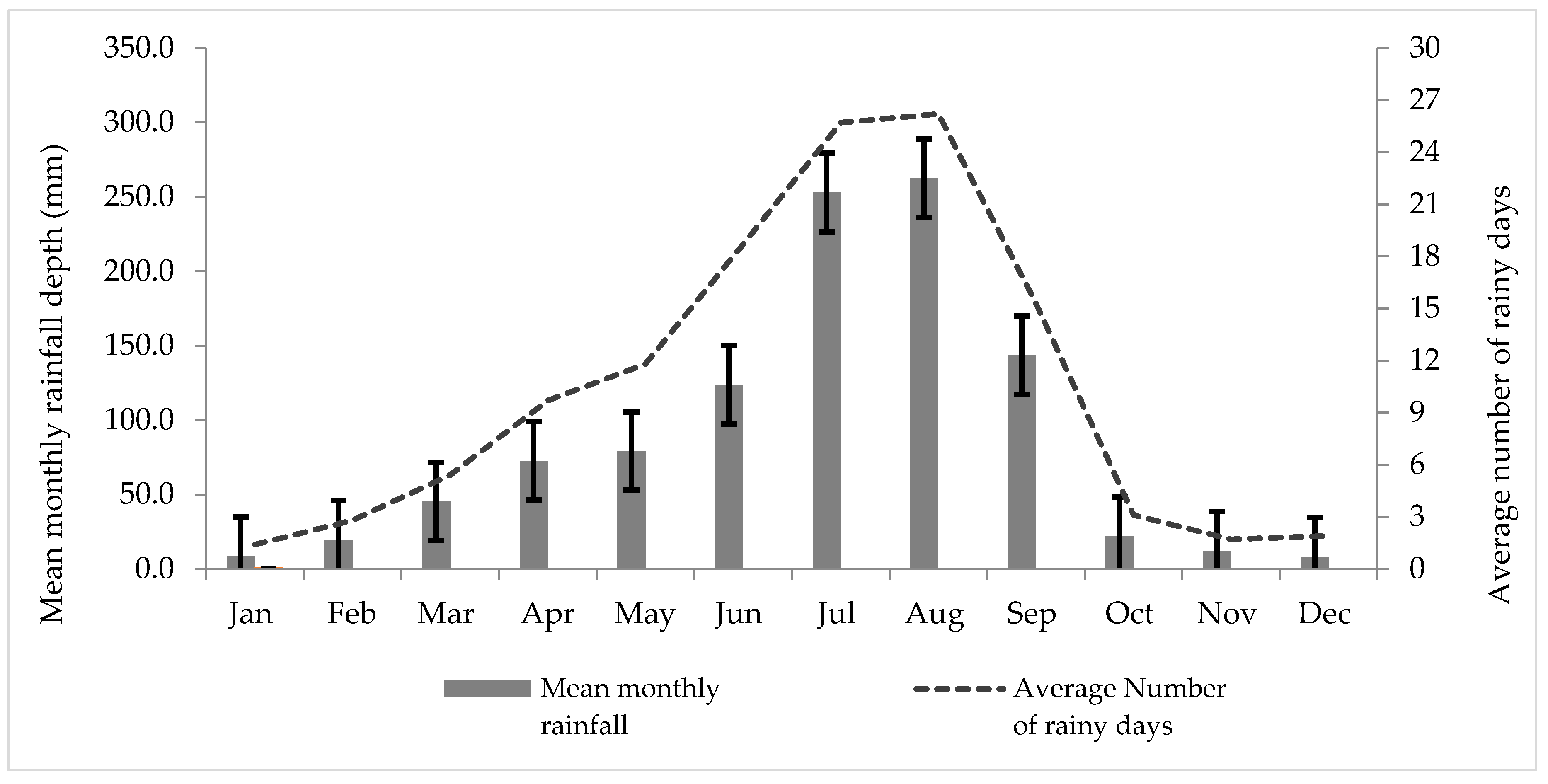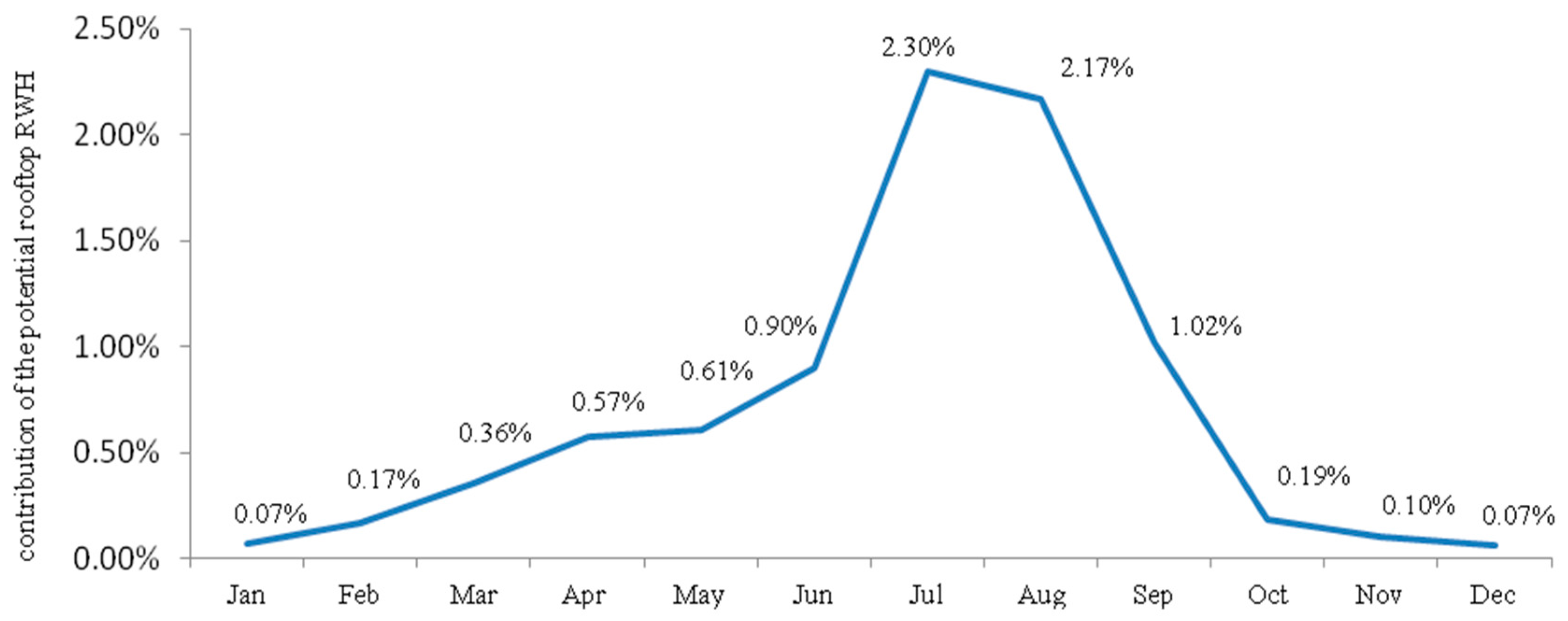Assessing the Potential for Rooftop Rainwater Harvesting from Large Public Institutions
Abstract
1. Introduction
2. Materials and Methods
2.1. Study Area
2.2. Rooftop Rainwater Harvesting
2.3. Rainfall Data Analysis
2.4. Water Supply Data
3. Results
3.1. Rainfall Variability
3.2. Potential of Rooftop RWH from Large Public Institutions to Supplement the Water Supply of Addis Ababa
3.3. Contribution of Potential Rooftop RWH from Large Public Institutions to Supplement Their Water Supply
4. Discussion
5. Conclusions
Acknowledgments
Author Contributions
Conflicts of Interest
References
- Gleick, P.H. Basic water requirements for human activities: Meeting basic needs. Water Int. 1996, 21, 83–92. [Google Scholar] [CrossRef]
- Wheida, E.; Verhoeven, R. An alternative solution of the water shortage problem in Libya. Water Resour. Manag. 2007, 21, 961–982. [Google Scholar] [CrossRef]
- Fang, C.L.; Bao, C.; Huang, J.C. Management implications to water resources constraint force on socio-economic system in rapid urbanization: A case study of the Hexi Corridor, NW China. Water Resour. Manag. 2007, 21, 1613–1633. [Google Scholar] [CrossRef]
- Seckler, D.; Barker, R.; Amarasinghe, U. Water scarcity in the twenty-first century. Int. J. Water. Resour. Dev. 1998, 15, 29–42. [Google Scholar] [CrossRef]
- United Nations. The Millennium Development Goals Report 2006; United Nations: New York, NY, USA, 2015. [Google Scholar]
- Haque, M.M.; Rahman, A.; Samali, B. Evaluation of climate change impacts on rainwater harvesting. J. Clean. Prod. 2016, 137, 60–69. [Google Scholar] [CrossRef]
- Central Statistical Agency of Ethiopia. Population and Housing Census of Ethiopia; Central Statistical Agency of Ethiopia: Addis Ababa, Ethiopia, 1984.
- Federal Democratic Republic of Ethiopia Central Statistical Agency. Population Projection of Ethiopia for All Regions from 2014–2017; Federal Democratic Republic of Ethiopia Central Statistical Agency: Addis Ababa, Ethiopia, 2013.
- Viste, E.; Korecha, D.; Sortenberg, A. Recent drought and precipitation tendencies in Ethiopia. Theor. Appl. Clim. 2013, 112, 535–551. [Google Scholar] [CrossRef]
- Samela, C. DEM-Based approaches for the delineation of flood-prone areas in an ungauged basin in Africa. J. Hydrol. Eng. 2016, 21, 06015010. [Google Scholar] [CrossRef]
- Addis Ababa Water and Sewerage Authority. Surface and Groundwater Supply Data; Department of Groundwater: Addis Ababa, Ethiopia, 2016. [Google Scholar]
- National Metrology Agency. Monthly Rainfall Data of Addis Abeba; National Metrology Agency of Ethiopia (NMA): Addis Ababa, Ethiopia, 2016.
- World Bank. Enhancing Urban Resilience in Addis Ababa: Resilient Cities Program; Document Number 100980; The World Bank Group: Addis Ababa, Ethiopia, 2015. [Google Scholar]
- Addis Ababa Water and Sewerage Authority. Business Plan from 2011 to 2020: Final Report; Addis Ababa Water and Sewerage Authority: Addis Ababa, Ethiopia, 2011. [Google Scholar]
- Steffen, J.; Jensen, M.; Pomeroy, C.A.; Burian, S.J. Water supply and stormwater management benefits of residential rainwater harvesting in US cities. J. Am. Water Resour. Assoc. 2013, 49, 810–824. [Google Scholar] [CrossRef]
- Ward, S.L. Rainwater Harvesting in the UK: A Strategic Framework to Enable Transition from Novel to Mainstream. Ph.D. Thesis, University of Exeter, Exeter, UK, 2010. [Google Scholar]
- Zhang, Y.; Chen, D.; Chen, L.; Ashbolt, S. Potential for rainwater use in high-rise buildings in Australian cities. J. Environ. Manag. 2009, 91, 222–226. [Google Scholar] [CrossRef] [PubMed]
- Herrmann, T.; Schmida, U. Rainwater utilization in Germany: Efficiency, dimensioning, hydraulic and environmental aspects. Urban Water 2000, 1, 307–316. [Google Scholar] [CrossRef]
- Alem, G. Rainwater Harvesting in Ethiopia: An Overview; Laughborough University: Laughborough, UK, 1999. [Google Scholar]
- Kahinda, J.M.; Taigbenu, A.E. Rainwater harvesting in South Africa: Challenges and opportunities. Phys. Chem. Earth 2011, 36, 968–976. [Google Scholar] [CrossRef]
- Ibrahim, M.B. Rainwater harvesting for urban areas: A success story from Gadarif city in central Sudan. Water Resour. Manag. 2009, 23, 2727–2736. [Google Scholar] [CrossRef]
- Aladenola, O.; Adeboye, O.B. Assessing the potential for rainwater harvesting. Water Resour. Manag. 2010, 24, 2129–2137. [Google Scholar] [CrossRef]
- Ghisi, E.; Montibeller, A.; Schmidt, R.W. Potential for potable water savings by using rainwater: An analysis over 62 cities in southern Brazil. Build. Environ. 2006, 41, 204–210. [Google Scholar] [CrossRef]
- Amin, M.T.; Alazba, A.A.; Elnesr, M.N. Adaptation of climate variability/extreme in arid environment of the Arabian peninsula by rainwater harvesting and management. Int. J. Environ. Sci. Technol. 2013, 10, 27–36. [Google Scholar] [CrossRef]
- Mehrabadi, M.H.R.; Saghafian, B.; Fashi, F.H. Assessment of residential rainwater harvesting efficiency for meeting non-potable water demands in three climate conditions. Resour. Conserv. Recycl. 2013, 73, 86–93. [Google Scholar] [CrossRef]
- Pandey, D.N.; Gupta, A.K.; Anderson, D.M. Rainwater Harvesting as an Adaptation to Climate Change. Curr. Sci. 2003, 85, 46–59. [Google Scholar]
- Sazakli, E.; Alexopoulos, A.; Leotsinidis, M. Rainwater harvesting, quality assessment and utilization in Kefalonia Island, Greece. Water Res. 2007, 41, 2039–2047. [Google Scholar] [CrossRef] [PubMed]
- Mendez, C.B.; Klenzendorf, J.B.; Afshar, B.R.; Simmons, M.T.; Barrett, M.E.; Kinney, K.A.; Kirisits, M.J. The effect of roofing material on the quality of harvested rainwater. Water Res. 2011, 45, 2049–2059. [Google Scholar] [CrossRef] [PubMed]
- Sample, D.J.; Liu, J. Optimizing rainwater harvesting systems for the dual purposes of water supply and runoff capture. J. Clean. Prod. 2014, 75, 174–194. [Google Scholar] [CrossRef]
- Wang, W.C.; Xu, D.M.; Chau, K.W.; Lei, G.J. Assessment of river water quality based on theory of variable fuzzy sets and fuzzy binary comparison method. Water Resour. Manag. 2014, 28, 4183–4200. [Google Scholar] [CrossRef]
- Abdulla, F.A.; Al-Shareef, A.W. Assessment of rainwater roof harvesting systems for household water supply in Jordan. In Integrated Urban Water Resources Management; Springer: Dordrecht, The Netherlands, 2006; pp. 291–300. [Google Scholar]
- Zaizen, M.; Urakawa, T.; Matsumoto, Y.; Takai, H. The collection of rainwater from dome stadiums in Japan. Urban Water 1999, 1, 355–359. [Google Scholar] [CrossRef]
- Kasa, L.; Zeleke, G.; Alemu, D.; Hagos, F.; Heinimann, A. Impact of Urbanization of Addis Abeba City on Peri-Urban Environment and Livelihoods; Sekota Dry land Agricultural Research Centre of Amhara Regional Agricultural Research Institute: Addis Ababa, Ethiopia, 2011. [Google Scholar]
- Thomas, T.H.; Martinson, D.B. Roof Water Harvesting: A Handbook for Practitioners; Technical Paper Series, No. 49; IRC International Water and Sanitation Center: Delft, The Netherlands, 2007. [Google Scholar]
- Engida, M. Annual rainfall and potential evapo-transpiration in Ethiopia. Ethiop. J. Natl. Resour. 1999, 1, 137–154. [Google Scholar]
- Gholami, V.; Chau, K.W.; Fadaee, F.; Torkaman, J.; Ghaffari, A. Modeling of groundwater level fluctuations using dendrochronology in alluvial aquifers. J. Hydrol. 2015, 529, 1060–1069. [Google Scholar] [CrossRef]
- Mikkelsen, P.S.; Adeler, O.F.; Albrechtsen, H.J.; Henze, M. Collected rainfall as a water source in Danish households: What is the potential and what are the costs? Water Sci. Technol. 1999, 39, 49–56. [Google Scholar]
- Kuczera, G. Regional Impacts of Roof Water Harvesting—Supplementing Public Water Supply; Rainwater Colloquium in Kuala Lumpur: Kuala Lumpur, Malaysia, 2007. [Google Scholar]
- Huttinger, A.; Brunson, L.; Moe, C.L.; Roha, K.; Ngirimpuhwe, P.; Mfura, L.; Kayigamba, F.; Ciza, P.; Dreibelbis, R. Small water enterprise in Rural Rwanda: Business development and year-one performance evaluation of nine water kiosks at health care facilities. Int. J. Environ. Res. Public Health 2017, 14, 1584. [Google Scholar] [CrossRef] [PubMed]
- Chau, K.W. Use of meta-heuristic techniques in rainfall-runoff modeling. Water 2017, 9, 186. [Google Scholar] [CrossRef]



| Large Public Institution | Rooftop Area (m2) | ||||
|---|---|---|---|---|---|
| No. | Category | Total Existing | Digitalized | Average of Digitalized | Total Estimated |
| 1 | Hospitals | 13 | 4 | 14,273 | 185,542 |
| 2 | Secondary schools | 27 | 7 | 2114 | 132,651 |
| 3 | Federal ministries | 44 | 11 | 2114 | 93,032 |
| 4 | Technical and vocational colleges/Schools | 10 | 3 | 7546 | 75,457 |
| 5 | Addis Ababa city bureaus and utility offices | 24 | 6 | 3059 | 75,198 |
| 6 | Local level (Woreda) administration offices | 166 | 10 (1) | 453 | 73,424 |
| 7 | Sub-city administration offices | 10 | 3 | 3368 | 33,683 |
| 8 | Health centers | 23 | 6 | 1119 | 25,729 |
| 9 | College of natural science | 1 | 1 | 25,790 | 25,790 |
| 10 | AAiT | 1 | 1 | 23,104 | 23,104 |
| 11 | EiABC | 1 | 1 | 23,103 | 23,103 |
| Sum | 320 | 50 | 766,713 | ||
| Jan. | Feb. | Mar. | Apr. | May | Jun. | Jul. | Aug. | Sep. | Oct. | Nov. | Dec. | |
|---|---|---|---|---|---|---|---|---|---|---|---|---|
| Monthly water supply (in 1000 m3) | 123,67 | 12,588 | 13,470 | 13,484 | 13,924 | 14,615 | 11,746 | 12,942 | 14,995 | 12,630 | 12,711 | 13,004 |
| Category of Institution (2) | Jan. | Feb. | Mar. | Apr. | May | Jun. | Jul. | Aug. | Sep. | Oct. | Nov. | Dec. |
|---|---|---|---|---|---|---|---|---|---|---|---|---|
| 1 | 1309 | 3091 | 7129 | 11,434 | 12,475 | 19,509 | 39,885 | 41,383 | 22,647 | 3470 | 1908 | 1293 |
| 2 | 936 | 2210 | 5096 | 8175 | 8919 | 13,948 | 28,515 | 29,586 | 16,191 | 2481 | 1364 | 925 |
| 3 | 656 | 1550 | 3574 | 5733 | 6255 | 9782 | 19,999 | 20,750 | 11,355 | 1740 | 957 | 648 |
| 4 | 532 | 1257 | 2899 | 4650 | 5073 | 7934 | 16,221 | 16,830 | 9210 | 1411 | 776 | 526 |
| 5 | 518 | 1223 | 2821 | 4525 | 4937 | 7720 | 15,784 | 16,376 | 8962 | 1373 | 755 | 512 |
| 6 | 531 | 1253 | 2889 | 4634 | 5056 | 7907 | 16,165 | 16,772 | 9179 | 1406 | 773 | 524 |
| 7 | 238 | 561 | 1294 | 2076 | 2265 | 3542 | 7241 | 7513 | 4111 | 630 | 346 | 235 |
| 8 | 182 | 429 | 989 | 1586 | 1730 | 2705 | 5531 | 5739 | 3141 | 481 | 265 | 179 |
| 9 | 182 | 430 | 991 | 1589 | 1734 | 2712 | 5544 | 5752 | 3148 | 482 | 265 | 180 |
| 10 | 163 | 385 | 888 | 1424 | 1553 | 2429 | 4967 | 5153 | 2820 | 432 | 238 | 161 |
| 11 | 163 | 385 | 888 | 1424 | 1553 | 2429 | 4966 | 5153 | 2820 | 432 | 238 | 161 |
| Category of Institution (3) | Monthly Water Consumption Data (in 1000 m3) | |||||||||||
|---|---|---|---|---|---|---|---|---|---|---|---|---|
| Jan. | Feb. | Mar. | Apr. | May | Jun. | Jul. | Aug. | Sept. | Oct. | Nov. | Dec. | |
| 1 | 75.0 | 70.3 | 67.8 | 57.6 | 56.5 | 58.7 | 108.2 | 89.1 | 84.6 | 84.7 | 100 | 92.9 |
| 2 | 21.9 | 21.1 | 19.2 | 21.6 | 25.8 | 35.3 | 21.2 | 19.3 | 19.3 | 14.9 | 20.3 | 21.4 |
| 3 | 77.7 | 82.4 | 86.1 | 88.7 | 60.6 | 99.2 | 68.2 | 53.5 | 53.7 | 50.7 | 58.3 | 71.8 |
| 4 | 5.1 | 4.8 | 5.3 | 5.6 | 5.4 | 5.2 | 5.04 | 4.9 | 4.8 | 5 | 5.2 | 5.7 |
| 5 | 27 | 16.5 | 15.6 | 16.2 | 10.5 | 12.2 | 5.9 | 19.9 | 20.1 | 12.6 | 16.3 | 11.6 |
| 6 | 3.7 | 3.3 | 3.2 | 2.8 | 3.2 | 3.3 | 2.5 | 2.7 | 2.5 | 2.3 | 2.5 | 2.5 |
| 7 | 14.7 | 16.2 | 12.4 | 15.6 | 13.6 | 10.4 | 18.5 | 13.2 | 9.8 | 7.5 | 8.9 | 10.0 |
| 8 | 5.3 | 5.3 | 4.6 | 4.9 | 5.3 | 5.6 | 5.2 | 5.0 | 5.4 | 5.5 | 5.9 | 5.7 |
| 9 | 15.5 | 8.6 | 11.5 | 14.8 | 14.8 | 14.8 | 14.9 | 16.0 | 12.2 | 9.4 | 11.9 | 14.3 |
| 10 | 10.7 | 10.7 | 9.7 | 9.9 | 8.9 | 8.1 | 11.2 | 8.2 | 7.9 | 8.5 | 7.6 | 11.8 |
| 11 | 4.9 | 5.0 | 4.1 | 3.2 | 4.3 | 1.9 | 8.8 | 1.1 | 1.02 | 4.1 | 4.3 | 5.0 |
| Large Public Institution | Water Supply Supplement from Rooftop RWH (%) | |||||||||||
|---|---|---|---|---|---|---|---|---|---|---|---|---|
| Jan. | Feb. | Mar. | Apr. | May | Jun. | Jul. | Aug. | Sep | Oct | Nov. | Dec. | |
| Hospitals | 1.8 | 4.4 | 10.5 | 19.9 | 22 | 33 | 37 | 46 | 27 | 4.1 | 1.9 | 1.4 |
| Secondary schools | 4.3 | 10.5 | 26.6 | 38 | 35 | 39 | 134 | 154 | 84 | 16.6 | 6.7 | 4.3 |
| Federal ministries | 0.9 | 1.9 | 4.2 | 6.5 | 10 | 9.9 | 29 | 39 | 21 | 3.4 | 1.6 | 0.9 |
| Technical and vocational colleges/Schools | 10.6 | 26 | 55 | 83 | 94 | 152 | 322 | 342 | 192 | 28 | 15 | 9.2 |
| Addis Ababa city bureaus and utility offices | 1.9 | 7.4 | 18.0 | 28.0 | 47 | 63 | 266 | 82 | 45 | 10.9 | 4.6 | 4.4 |
| Local level administrations (Woredas) | 14.5 | 37.7 | 92 | 164 | 160 | 238 | 649 | 632 | 369 | 61 | 31 | 21 |
| Sub-city administration offices | 1.6 | 3.5 | 10.4 | 13.3 | 17 | 34 | 39 | 57 | 42 | 8.4 | 3.9 | 2.3 |
| Health centers | 3.5 | 7.8 | 21.6 | 32.6 | 33 | 48 | 106 | 115 | 58 | 8.7 | 4.5 | 3.1 |
| College of natural science | 1.2 | 5.0 | 8.7 | 11 | 12 | 18 | 37 | 36 | 26 | 5.1 | 2.2 | 1.3 |
| AAiT | 1.5 | 3.6 | 9.1 | 14 | 17 | 30 | 44 | 63 | 36 | 5.1 | 3.1 | 1.4 |
| EiABC | 3.3 | 7.7 | 21.6 | 45 | 36 | 128 | 568 | 500 | 277 | 10.4 | 5.5 | 3.2 |
© 2018 by the authors. Licensee MDPI, Basel, Switzerland. This article is an open access article distributed under the terms and conditions of the Creative Commons Attribution (CC BY) license (http://creativecommons.org/licenses/by/4.0/).
Share and Cite
Adugna, D.; Jensen, M.B.; Lemma, B.; Gebrie, G.S. Assessing the Potential for Rooftop Rainwater Harvesting from Large Public Institutions. Int. J. Environ. Res. Public Health 2018, 15, 336. https://doi.org/10.3390/ijerph15020336
Adugna D, Jensen MB, Lemma B, Gebrie GS. Assessing the Potential for Rooftop Rainwater Harvesting from Large Public Institutions. International Journal of Environmental Research and Public Health. 2018; 15(2):336. https://doi.org/10.3390/ijerph15020336
Chicago/Turabian StyleAdugna, Dagnachew, Marina Bergen Jensen, Brook Lemma, and Geremew Sahilu Gebrie. 2018. "Assessing the Potential for Rooftop Rainwater Harvesting from Large Public Institutions" International Journal of Environmental Research and Public Health 15, no. 2: 336. https://doi.org/10.3390/ijerph15020336
APA StyleAdugna, D., Jensen, M. B., Lemma, B., & Gebrie, G. S. (2018). Assessing the Potential for Rooftop Rainwater Harvesting from Large Public Institutions. International Journal of Environmental Research and Public Health, 15(2), 336. https://doi.org/10.3390/ijerph15020336





